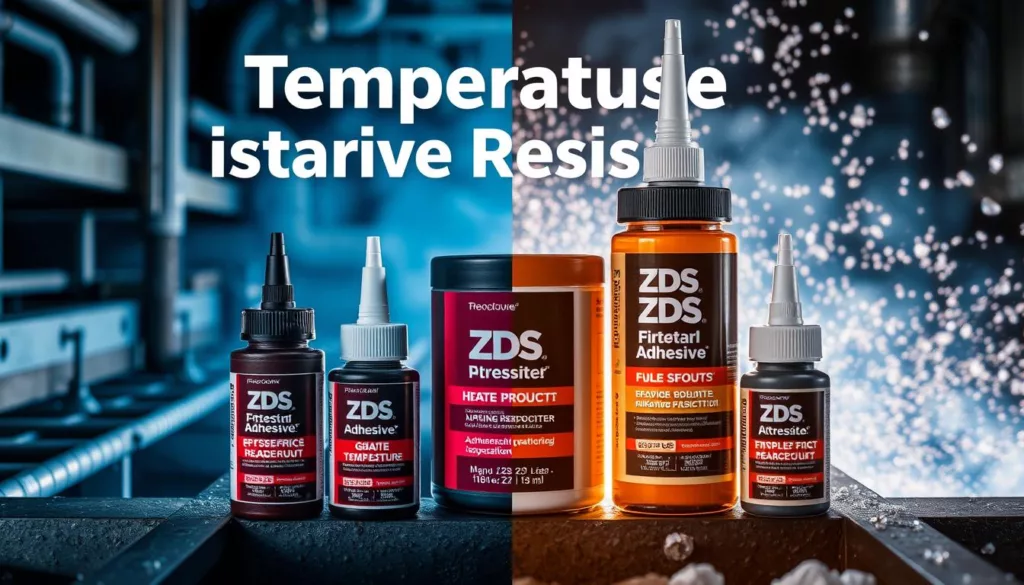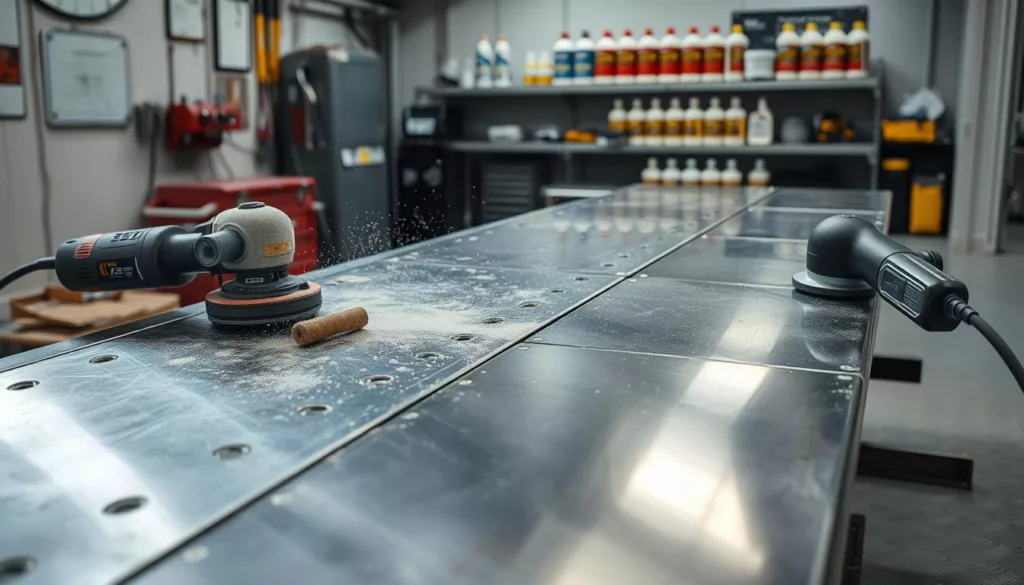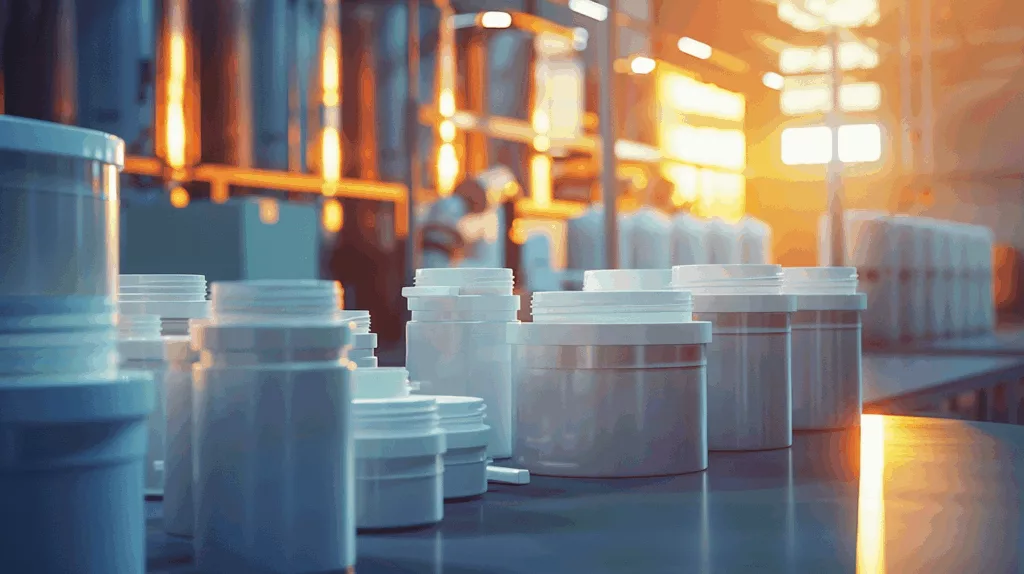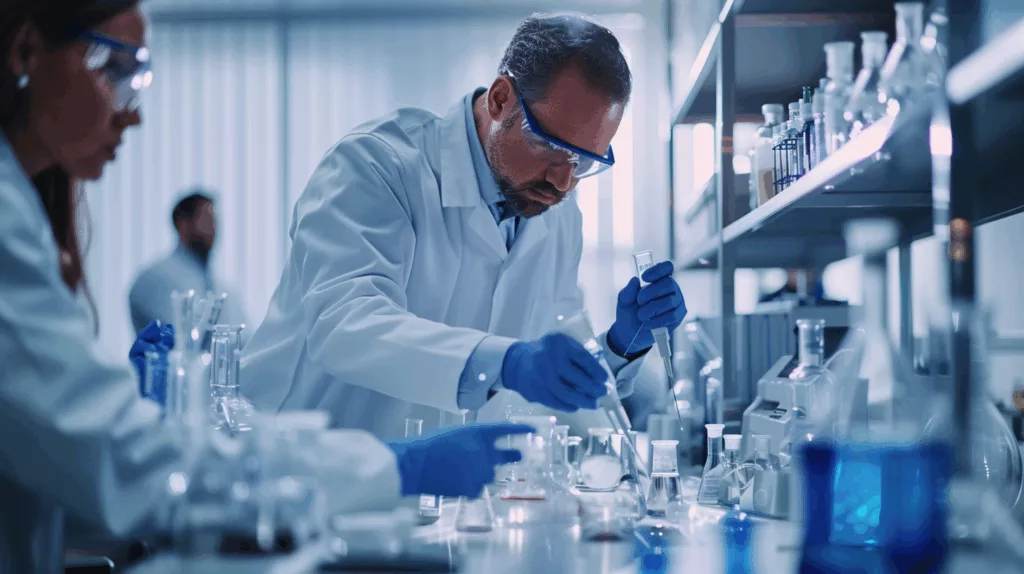In today’s world, a good chemical-resistant industrial adhesive for metal is key. Both pros and DIY fans need to know about industrial metal adhesives. These adhesives stand up to tough conditions, making strong bonds for many uses.
They’re vital in car making and building, among others. Picking the right adhesive is key for lasting results in metal work.
Key Takeaways
- Chemical-resistant adhesives are essential for strong, durable metal bonding.
- Industrial metal adhesives provide superior stress resistance and longevity.
- Choosing a high-strength metal adhesive is critical for performance in demanding environments.
- Different applications, such as automotive and aerospace, require specific adhesive properties.
- Understanding surface preparation enhances the effectiveness of adhesives.
Introduction to Chemical-Resistant Adhesives
Chemical-resistant adhesives are key in today’s manufacturing and construction. They are made to handle harsh chemicals and different environments. This makes them vital for bonding metal structures.
What Are Chemical-Resistant Adhesives?
These adhesives are made with new technologies to resist many chemicals. They create strong bonds, keeping metal parts together in tough conditions. They’re used in many fields where reliability is a must.
Importance of Adhesives in Metal Structures
Adhesives are very important for metal structures. They have many benefits over old ways of joining, like:
- They spread loads better, cutting down stress points.
- They keep moisture and dirt out, stopping rust.
- They let for more creative designs.
- They make structures look better by hiding fasteners.
Using a top-notch chemical-resistant adhesive helps structures last longer. They can handle physical and chemical stress better. This makes metal parts last longer in many uses.
Types of Chemical-Resistant Adhesives for Metal
It’s important to know the different types of chemical-resistant adhesives for metal. Each type has its own benefits for various industrial needs.
Epoxy-Based Adhesives
Epoxy-based adhesives are known for their strong bonding and durability. They protect against chemicals, moisture, and extreme temperatures. Epoxy adhesives have several advantages:
- Superior bond strength: Great for heavy-duty tasks.
- Excellent gap-filling properties: Good for uneven surfaces.
- Long curing times: Allows for precise application.
Polyurethane Adhesives
Polyurethane adhesives are flexible and resilient. They work well in places where surfaces move due to temperature changes. Their key features are:
- High elasticity: Keeps adhesion even under stress.
- Resistance to moisture and chemicals: Protects against damage.
- Fast curing times: Quick for production lines.
Acrylic Adhesives
Acrylic adhesives bond quickly and resist weathering and UV light. They’re great for applications that need to be clear or look good. Their notable traits are:
- Quick curing time: Fast for assembly.
- High durability: Lasts through harsh conditions.
- Color clarity options: Perfect for decorative uses.
Key Features of Industrial Adhesives
Industrial adhesives work well because of key features. Knowing these helps them fit many industries, like metal work.
Temperature Resistance
Adhesives need to handle extreme temperatures. Good ones stay strong even when it’s hot or cold. This is key in places like airplanes and cars.
Chemical Resistance
Adhesives must also resist chemicals. They should not break down when exposed to harsh substances. This is important in places like factories.
Choosing the right adhesive is vital for lasting bonds. For more info, see the guide on structural acrylic adhesives.
Bonding Strength
The strength of the bond is what matters most. A strong bond keeps things together, even when stressed. This is critical in safe places like buildings and cars.
Applications of Chemical-Resistant Adhesives
Chemical-resistant adhesives are key in many industries. They make materials last longer in tough conditions. We’ll look at their use in cars, planes, and buildings.
Automotive Industry
In cars, these adhesives are vital. They keep parts together under stress, heat, and chemicals. They make cars lighter but stronger.
Adhesives like epoxy work well with car parts. This is because they stick well to metals and plastics.
Aerospace Applications
For planes, adhesives must be tough. They hold materials like composites and metals together. This is important for safety and performance.
Using epoxy ensures bonds stay strong. This is true even when temperatures change or chemicals are present.
Construction and Structural Engineering
In building, adhesives are key for lasting structures. They seal and bond materials, making buildings stable. They protect against moisture and temperature changes.
Choosing the right adhesive is critical. For more on picking the best for metal bonding, check this resource.
How to Choose the Right Adhesive
Choosing the right adhesive for metal projects is key to success. You need to analyze metal types, consider the environment, and check performance needs. Knowing these well helps create a strong bond for your task.
Evaluating Metal Types
Different metals have unique traits that affect adhesive choice. Important factors include:
- Surface properties
- Thermal expansion
- Corrosion resistance
Knowing the metal’s properties helps pick the right adhesive. This ensures a strong, lasting bond.
Considering Environmental Factors
Environmental conditions affect adhesive performance. Key factors are:
- Temperature changes
- Moisture exposure
- Chemical exposure
These factors are vital for the adhesive’s durability. Evaluating them ensures the adhesive meets durability standards.
Assessing Performance Requirements
Identifying your project’s needs is critical. Considerations include:
- Bond strength needs
- Curing time
- Chemical and temperature resistance
Assessing these needs helps make a smart choice. This ensures the adhesive meets project demands. For more on bonding, check this guide.
Preparing Metal Surfaces for Adhesives
Getting metal surfaces ready is key for strong adhesive bonds. The success of adhesives depends on the metal’s condition. We’ll look at important cleaning steps and why surface roughness matters.
Surface Cleaning Techniques
Cleaning metal surfaces well is essential before applying adhesives. We need to remove dirt, oils, or moisture to ensure a strong bond. Here are some common cleaning methods:
- Degreasing: Using solvents or degreasers to remove oils and greases.
- Abrasive Cleaning: Sandpaper, brushes, or blasting to get rid of rust and oxides.
- Steam Cleaning: High-temperature steam to clean off residues and disinfect.
- Mechanical Cleaning: Grinders or buffers for a smooth finish.
Importance of Surface Roughness
Surface roughness is very important for adhesion. A rough surface helps the adhesive stick better by increasing contact area. The benefits include:
- Stronger bond strength.
- Better resistance to peel forces.
- Less chance of adhesive failure.
Application Techniques for Adhesives
The right adhesive and application method are key to strong bonds. Using both manual and automated systems can make bonds stronger and more consistent. Knowing how to cure the adhesive is also important for the best results.
Manual Application Methods
Manual methods are popular for their control and flexibility. They allow for precise adhesive placement, which is vital for accurate work. Some common methods include:
- Brush Application: Great for big areas or detailed designs without waste.
- Glue Gun: Fast bonding with hot-melt adhesives, perfect for quick fixes.
- Epoxy Syringes: Good for careful application, reducing excess and ensuring the right mix.
Automated Dispensing Systems
Automated systems are gaining ground in factories for their precision and speed. They help apply adhesives consistently, saving time and money. Key features include:
- Programmable Settings: Can be set for different adhesives and materials.
- Real-Time Monitoring: Keeps quality high by following application rules.
- Integration with Manufacturing Lines: Makes production smoother, handling large volumes.
Curing Processes
The curing process is vital for strong bonds. Different methods suit various needs:
- Ambient Curing: Uses room temperature for bonding and setting at the same time.
- Heat Curing: Speeds up curing and strengthens bonds, great for epoxy.
- UV Curing: Quick process using UV light, best for clear materials.
Choosing the right application method and understanding curing is key. This ensures the best results with industrial adhesives for metal.
Health and Safety Considerations
Working with chemical-resistant adhesives requires careful attention to health and safety. Knowing the right precautions helps keep people safe and boosts work efficiency. This part talks about the importance of wearing personal protective equipment and following safe handling rules.
Personal Protective Equipment (PPE)
Using the right personal protective equipment is key to avoiding chemical risks. Here are the main PPE items you need for working with adhesives:
- Gloves: Chemical-resistant gloves protect your hands from harmful chemicals.
- Goggles: Safety goggles keep your eyes safe from adhesives and other chemicals.
- Respirators: You need proper respiratory gear in places with bad air or lots of vapors.
- Protective Clothing: Wearing full-length protective clothes keeps your skin safe from spills and splashes.
Safe Handling Guidelines
Safe handling practices are vital to avoid health risks when working with chemical-resistant adhesives. Here are some important guidelines:
- Ventilation: Make sure work areas have good air flow to lower breathing risks.
- Storage: Keep adhesives in labeled containers, away from things that could react badly.
- Spill Management: Have plans ready to handle spills quickly.
- Training: Give everyone working with chemicals the training they need to use them safely.
Common Challenges in Adhesive Applications
In adhesive applications, many challenges can occur. These can affect how well the adhesive works. Knowing these challenges helps us pick the right adhesives for our needs.
Incompatibility with Certain Metals
Metal incompatibility is a big problem in adhesive use. Metals like aluminum and steel don’t always stick well with some adhesives. This is because of their unique chemical makeup.
This issue can cause weak bonds and early failure. It’s important to choose an adhesive that works well with the metals being joined. Using adhesives from brands like ZDS™ can help solve these problems and ensure strong bonds.
Environmental Conditions Affecting Bonding
Environmental factors are also key in adhesive success. Heat, moisture, and chemicals can weaken adhesive bonds. It’s important to know the environment the adhesive will be in.
Doing the right tests and picking the right products can lead to better results. For more tips on picking adhesives for metal projects, check out choosing the right adhesive.
Future Trends in Adhesive Technology
The adhesive industry is changing fast, thanks to new technologies. Advances in chemical resistance are leading the way. These changes are making adhesives better and more durable in many fields.
Innovations in Chemical Resistance
New formulas are being made to handle harsh chemicals better. This means adhesives can work in tougher conditions without losing strength. It’s a big deal for places where safety and lasting power matter most.
Sustainable Adhesive Solutions
There’s also a big push for green adhesives. Companies are working on products that are good for the planet and work well. This move is key for following rules and for businesses wanting to be more eco-friendly.
FAQ
What are chemical-resistant industrial adhesives for metal structures?
These adhesives are made to stick metal together well. They also protect against harsh chemicals and weather. They’re key in many fields like cars, planes, and buildings.
Why are chemical-resistant adhesives important in metal structure bonding?
They keep metal parts together in tough places. They make metal last longer, even in places where chemicals can damage it.
What types of chemical-resistant adhesives are commonly used for metal bonding?
You’ll find epoxy, polyurethane, and acrylic adhesives. Each has special qualities for different jobs and places.
What key features should I look for in industrial metal adhesives?
Look for things like how well they handle heat and chemicals. Also, check their sticking power. These are important for tough jobs.
In what applications are chemical-resistant adhesives utilized?
They’re used in cars, planes, and buildings. They help hold metal parts together in these areas.
How can I choose the right adhesive for my metal project?
Think about the metal, the weather, and what you need it to do. Pick one that fits your project best.
What is the best way to prepare metal surfaces for adhesive bonding?
Clean the metal well to remove dirt and oils. Make sure it’s rough enough for the adhesive to stick well.
What application techniques are recommended for these adhesives?
For small jobs, you can apply it by hand. For bigger ones, use machines. Always follow the drying instructions for the best results.
What health and safety considerations should I be aware of when using chemical-resistant adhesives?
Wear the right safety gear to protect yourself. Follow the safe use rules to avoid accidents.
What are common challenges faced with adhesive applications on metal?
Problems can include not working with certain metals or being affected by moisture or extreme temperatures. These can mess up the bond.
What are future trends in adhesive technology?
The field is growing with new, better adhesives. They’re working on ones that are safe for the planet but just as strong.













